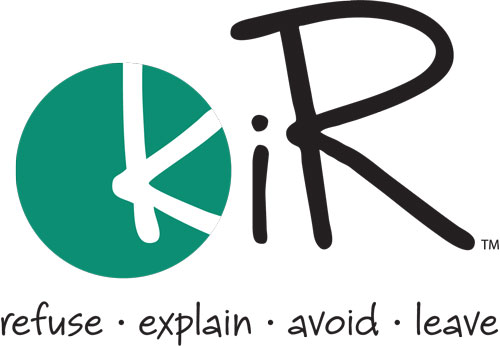keepin' it REAL Rural
- Need: A drug and alcohol prevention program for middle school students that is specific to rural culture.
- Intervention: An adaptation of the evidence-based keepin' it REAL curriculum was customized for rural middle school students.
- Results: Students showed a reduction in all substance use and less personal acceptability of substance use.
Evidence-level
Evidence-Based (About evidence-level criteria)Description
 The Drug Resistance
Strategies (DRS) Project, funded by the National Institute on Drug
Abuse, examines how adolescents refused drug offers.
This research led to the development of the multicultural
school-based substance use prevention program, keepin' it
REAL (kiR). "REAL" is an acronym for Refuse, Explain,
Avoid, and Leave. These four strategies of saying "no"
were the most common responses among 300 interviews with
youth across the country. Using these stories, program
creators Dr. Michelle Miller-Day and Dr. Michael Hecht
constructed ten interactive lessons that use video and
other highly involving teaching techniques.
The Drug Resistance
Strategies (DRS) Project, funded by the National Institute on Drug
Abuse, examines how adolescents refused drug offers.
This research led to the development of the multicultural
school-based substance use prevention program, keepin' it
REAL (kiR). "REAL" is an acronym for Refuse, Explain,
Avoid, and Leave. These four strategies of saying "no"
were the most common responses among 300 interviews with
youth across the country. Using these stories, program
creators Dr. Michelle Miller-Day and Dr. Michael Hecht
constructed ten interactive lessons that use video and
other highly involving teaching techniques.
kiR's motto is "From kids, through kids, to kids." The prevention messages of kiR reflect aspects of adolescents' actual experiences told by the kids themselves. The program's curriculum utilizes a "cultural grounding" model to incorporate traditional cultural values and practices to protect against substance use.
Much like the initial program formation, the rural adaptation of kiR used interviews to construct a culturally grounded curriculum. To better understand substance offers in the rural context, 118 semi-structured interviews were conducted with 12- to 19-year-old adolescents from rural school districts in Pennsylvania and Ohio. Also similar to the original kiR, high school students were paired with film personnel to make five-minute videos central to the prepared lessons.
The following video briefly highlights the development of the kiR prevention curriculum:
In 2007, this program was funded by a National Institute on Drug Abuse grant.
Services offered
Features of the curriculum include 10 lessons delivered over a 10-week period. Lessons offer students the opportunity to act out the REAL strategies of Refuse, Explain, Avoid, and Leave. All lessons:
- Run for 40-45 minutes
- Promote interaction between students and teachers
- Feature fun-themed activities that engage students in learning
The curriculum also uses a series of five videos produced by youth and based on students' real stories as a key learning tool. To ensure that the video material is relevant and engaging, creative teams of high school students from Pennsylvania and Ohio produced the videos to reflect local culture.
Here is an introductory video from students who have developed videos for the kiR program:
For consistency in delivery, each lesson is constructed the same way:
- Review the previous lesson.
- Show the animated introduction story to engage students, review the previous lesson, and introduce this week's lesson.
- Explain the basic concepts.
- Describe the concepts and skills.
- Practice the skills.
- Apply the Decision-Making Model.
- Review the lesson and complete the Journaling activity.
- Show the Closing Story.
Additional materials included with the program are program evaluation materials, a certificate of completion template that can be customized for each student, and three supplemental lessons focused on students producing their own prevention videos.
Results
According to a 2015 Prevention Science study, positive changes were observed in students who received the rural kiR program.
When curriculum was delivered with higher levels of teacher and student engagement, students showed positive outcomes compared to students receiving a poorly implemented program, which might only meet curriculum objectives. When engagement was high, students reported:
- Less overall drug use
- Less personal acceptability of substance use
- A reduction in alcohol use
- A reduction in smoking and chewing tobacco use
- A reduction in marijuana use
- Conservative perceptions of peer prevalence
Efficacy and peer acceptability were not significantly altered. However, since kiR presents substance use as a risk with potentially negative consequences and not as an inherent wrong, it follows that the program would have little effect on this variable.
A 2008 cost-benefit analysis from the Substance Abuse and Mental Health Services Administration (SAMHSA) Center for Substance Abuse Prevention suggests that kiR returns $28 for every dollar spent.
The 2016 U.S. Surgeon General's Report on Alcohol, Drugs, and Health highlights the keepin' it REAL drug prevention curriculum as one of the most effective and cost-effective U.S. programs.
keepin' it REAL Rural has programs in the following states:
-
 Arizona
Arizona
- Georgia
- Indiana
- Kentucky
- Louisiana
- Nebraska
- New Jersey
- North Dakota
- Ohio
- Pennsylvania
- Virginia
- Washington
In 2009, Drug Abuse Resistance Education (D.A.R.E.) adopted the kiR curriculum. The D.A.R.E. scientific advisory board selected kiR from over 200 listings on a national registry of evidence-based programs maintained by SAMHSA. D.A.R.E. has expanded the kiR program to numerous communities, both urban and rural.
Research and publications relating to kiR Rural:
Hecht, M.L., Shin, Y.J., Pettigrew, J., Miller-Day, M., & Krieger, J.L. (2018). Designed Cultural Adaptation and Delivery Quality in Rural Substance Use Prevention: An Effectiveness Trial for the keepin' it REAL Curriculum. Prevention Science, 19(8), 1008-1018.
Shin, Y.J., Miller-Day, M., Hecht, M.L., & Krieger, J.L. (2018). Entertainment-Education Videos as a Persuasive Tool in the Substance Use Prevention Intervention "keepin' it REAL." Health Communication, 33(7), 896-906.
Pettigrew, J., Graham, J.W., Miller-Day, M., Hecht, M.L., Krieger, J.L., & Shin, Y.J. (2015). Adherence and Delivery: Implementation Quality and Program Outcomes for the 7th Grade keepin' it REAL Program. Prevention Science, 16(1), 90-99.
Colby, M., Hecht, M.L., Miller-Day, M., Krieger, J.L., Syvertsen, A.K., Graham, J.W., & Pettigrew, J. (2013). Adapting School-Based Substance Use Prevention Curriculum through Cultural Grounding: A Review and Exemplar of Adaptation Processes for Rural Schools. American Journal of Community Psychology, 51(0), 190-205.
Pettigrew, J., Miller-Day, M., Krieger, J., & Hecht, M.L. (2012). The Rural Context of Illicit Substance Offers: A Study of Appalachian Rural Adolescents. Journal of Adolescent Research, 27(4), 523-550.
Pettigrew, J., Miller-Day, M., Krieger, J., & Hecht, M.L. (2011). Alcohol and Other Drug Resistance Strategies Employed by Rural Adolescents. Journal of Applied Communication Research, 39(2), 103-122.
Challenges
Communities and schools differ widely in their resources, which was a challenge in first designing the rural adaptation. The variance in resources seriously impacted any strategy for local production of narrative substance use prevention videos as well as the ability to recruit local partners in curriculum development. For example, rural schools had less access to video production facilities and faculty expertise than the urban schools that participated in the development of the original set of kiR videos.
Another challenge for a program based on "cultural grounding" comes from the fact that rural adolescents are not a homogenous population. The program creators stated that it was important to avoid stereotypes of rural life. Although many share a common living experience, such as isolation from urban sprawl, it's possible for kids to hold different family values, political views, and opinions of authority.
Additionally, rural identity played both a positive and negative factor in substance prevention. For example, identity and societal role were strongly tied to the "small town" social reality. Being labeled as a substance user of any kind meant that information could easily spread to family members within the close-knit circle of rural communities. On the other hand, rural communities can come with ingrained dangers to substance introduction. Program creators observed that cultural "rites of passage" (such as boys trying beer or chewing tobacco on a hunting trip) were far more prevalent in rural communities.
Replication
With such a focus on culturally grounded curriculum, it is highly encouraged to execute internal interviews and then create local videos and other media materials used in the program to reflect local reality. Live performances are also an option. Regardless of the tactic used, both provide essential engagement among students and an opportunity for creativity.
More information is available on the REAL Prevention: keepin' it REAL website. Materials are mailed out based on request.
Another option is to connect with your local D.A.R.E. program. Police officers teach curriculum as a police/school relationship bond, thus avoiding any extra responsibility on school faculty.
Topics
Alcohol use
· Children and youth
· Illicit drug use
· Schools
· Substance use and misuse
· Tobacco use
· Wellness, health promotion, and disease prevention
States served
National/Multi-State, Ohio, Pennsylvania
Date added
December 18, 2015
Suggested citation: Rural Health Information Hub, 2025. keepin' it REAL Rural [online]. Rural Health Information Hub. Available at: https://www.ruralhealthinfo.org/project-examples/872 [Accessed 30 June 2025]
Please contact the models and innovations contact directly for the most complete and current information about this program. Summaries of models and innovations are provided by RHIhub for your convenience. The programs described are not endorsed by RHIhub or by the Federal Office of Rural Health Policy. Each rural community should consider whether a particular project or approach is a good match for their community’s needs and capacity. While it is sometimes possible to adapt program components to match your resources, keep in mind that changes to the program design may impact results.
